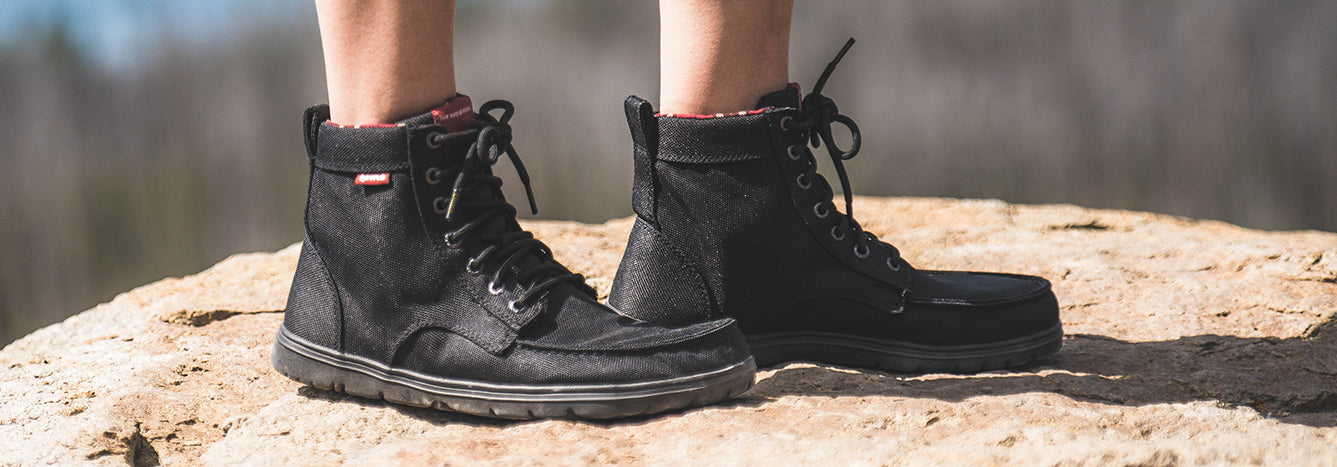Long-term use of narrow shoes has lasting consequences on the foot’s functional anatomy and are legitimately tied to bunion formation - a painful bony bump that develops at the big toe joint. While many believe bunions are inherited, research backing this belief is uncertain. More firmly established research provides evidence that narrow shoes, especially on feet that are still growing, is the root cause of bunions.

A bunion forms when the foot is chronically crammed into a shoe with a narrow toe box, which causes the first bone under the big toe to repeatedly turn outward. Simultaneously, the big toe turns inward, forcing the joint to jut out. In this condition, many negative forces are at work, prying continuously into the base of the big toe at each step. This is how bunion growth begins and becomes accelerated with ongoing use of narrow shoes, leading to poor foot health.
Why are most shoes narrow anyway? Plain and simple: a narrow shoe looks better, and is more sleek. For most athletic shoes, a narrow toe box makes the shoe look aerodynamic and fast. For most conventional running shoes, a narrow toe-box is a design feature that facilitates a faster foot rollover, propelling the body forward more easily. However, the real cost of this design is the heavy assault on the natural shape and function of the human foot.
It’s not just the narrow toe box of a shoe that drives bunion growth. Heel elevation of a shoe, from high heeled fashion shoes to running shoes with a stacked cushioned heel, sparks bunion formation as well. A 2011 study from Harvard Women's Health Watch found that walking and running in heeled footwear rapidly tips the bodyweight forward, shifting heavy pressures to the front of the foot; more so on the base of the big toe and eventually becomes too much for the joint to take on. This added weight and overpressure forces the forefoot into the front of the shoe, causing the toes to bend inward and squeeze tightly together. In this condition, if the shoe has a narrow toe box (like most heeled shoes do), it cannot accommodate such protrusions of the forefoot. Consequentially, each step fundamentally reshapes and misshapes the forefoot into a more narrow frame and results in pressure-driven bunion growth.

Ultimately, your footwear shouldn't be a source of pain. If your shoe is wide, that’s not enough. It needs to be flat to more optimally strengthen the toes ability to expand and engage more fully, which not only stops bunion growth, but aids in sturdier balance. Another added value of toe splay is that it gives the foot more spatial ability to provide better impact on deflection and absorption, granting the lower leg an added layer of natural impact protection. These are just some of the many benefits that follow when the foot can expand to its natural state.
The bottom line is the feet are like seeds, and with continued nurturing, they will flourish. This is why it’s important to wear a shoe with a structure that pairs perfectly with the shape and functional needs of the human foot. If you want to get your feet back on a healthier, pain-free path, Lems are the perfect choice for bunion sufferers because of their signature wide and flat design, encouraging forefoot expansion and toe splay. This also makes it easier to reverse bunion growth and acquire a wider forefoot that’s stronger and more balanced with the ground.
Always remember that the issue of bunions comes down to footwear! The best option for change is by wearing a shoe that has a fit that compliments the natural shape of the foot, and grants a wide toe splay. From this, bunions will be a distant worry and you’ll always have a stronger and safer foundation between yourself and the ground.
References:
Loli PJ. What to do about bunions. Harvard Womens Health Watch, 2011, pp.4-7

